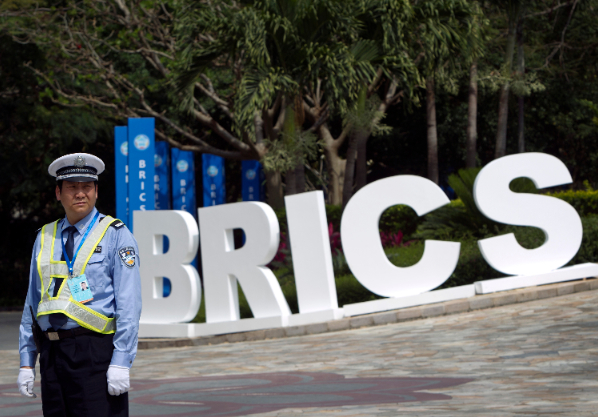

Follow us on:  
|


The currencies of three BRICS economies have steadily strengthened against the US dollar in recent weeks.
Brazil’s real, Russia’s ruble and South Africa’s rand have benefited from a ‘pause’ in the momentum to raise interest rates, particularly in the US.
All three countries have battled recession in contrast to BRICS members China and India, which are forecast to grow 6.7 per cent and 7.6 per cent, respectively, in 2016.
The rand is up nearly 15 per cent against the dollar in 2016 after suffering a significant slump in mid-2015.
The ruble rose 1.23 per cent earlier this week before retreating somewhat.
The increase followed a rally in China which pulled up other emerging markets. The ruble is up more than 20 per cent against the dollar in eight months.
Brazil’s real, which has suffered political and economic turbulence in the past two years, also strengthened against the dollar this week closing at its highest level – up nearly 25 per cent – in a year.
South Africa’s rand, following the uncertainty of Brexit, is the currency that has strengthened the most against the US dollar among emerging markets.
The regained strength has impacted South Africa’s position among other economies on the continent. Last week, it nudged out Nigeria to regain its position as Africa’s biggest economy despite a 1.6 contraction in the first quarter.
Another contraction will mean that the economy has fallen into recession.
It had grown by 0.4 per cent in 2015’s Q4.
The new ranking comes largely because of the rand’s strength – GDP growth in South Africa is now at over $301 billion while Nigeria’s is $296 billion. Egypt, which is ranked third, has a GDP of $270 billion, but this could change if anticipated currency devaluation materializes in the coming weeks.
While South Africa’s GDP growth for 2015 stood at 1.2 per cent, it is forecast to grow at just 0.6 per cent in 2016, according to the World Bank’s report Global Economic Prospects: Divergences and Risks.
In June, ratings agency Fitch said that South Africa’s “BBB- rating reflects low trend GDP growth, significant fiscal and external deficits, and high debt levels, which are balanced by strong policy institutions, deep local capital markets and a favourable government debt structure”.
Russia
Russia is closer to turning the corner on recession, officials from the country’s finance ministry have maintained for the past several months.
This may be the case if new data from the federal statistics service Rosstat is to be believed. According to the new figures, the economy’s contraction decreased to 0.6 in the second quarter from 1.2 per cent contraction in the first quarter.
Russia’s 1.2 contraction in the first quarter came largely due to lower-than-expected global oil prices – falling drastically to just above $26 a barrel in February.
Russia, which is the largest oil exporter in the world, will likely remain in recession if oil prices fall below $30 a barrel.
But oil prices rallied at the beginning of the second quarter, pivoting about $50 a barrel for several weeks.
Although prices have fallen again in fears of an oil glut, energy futures have regained ground to the mid $40s this week.
Based on a level price of $40 a barrel, Russia’s Ministry of Economic Development forecasts that the GDP will contract by 0.2 per cent this year, improving to zero per cent in the third quarter, and jumping back to growth territory at 1.2 per cent by the end of 2016.
An IMF report released in mid-July reiterated the positive momentum:
“Higher oil prices are providing some relief to the Russian economy, where the decline in GDP this year is now projected to be milder, but prospects of a strong recovery are subdued given long-standing structural bottlenecks and the impact of sanctions on productivity and investment,” the IMF report said.
Brazil reawakening?
Meanwhile in Brazil, economic data points to a reawakening of sorts, the IMF says.
It said that Brazil’s contraction (3.8 per cent) in 2016 would moderately subside to (3.3 per cent) in 2017. It forecast positive growth for Brazil in 2017 but voiced concern over ongoing corruption and political scandals which have rocked Brazil.
Brazil seems to be moving in the right direction, says global financial services firm UBS.
It said in a report on August 1 that the change in political leadership contributed to the strengthening of the currency real; it reiterated the IMF’s view that 2017 could mark a turnaround for the Brazilian economy.
Meanwhile, the positive data continues.
The MSCI’s benchmark EM index – which measures equity market performance in some 23 emerging countries – has overall jumped more than four per cent in July, registering the highest level in a year.
The MSCI EM index comprises 10 per cent of world market capitalization.
But the MSCI Brazil index for July came in at 7.5 per cent, beating the figures for 22 other emerging markets.
Moody’s, the global credit ratings firm, also voiced optimism about improving economic performance in many emerging markets.
In its report released yesterday, it modified its forecasts for emerging markets in the G20 saying they would reach growth of 4.4 per cent in 2016 and 5 per cent next year.
Particular bright spots included Brazil, China and Russia. Moody’s said strengthened confidence in the business environment in Brazil contributed to a better outlook for 2017.
Overall, Moody’s said in its report that commodity prices which had slumped last year were slowly regaining ground – as were oil prices. Both will contribute to stronger emerging markets by 2017.
The BRICS Post with inputs from Agencies